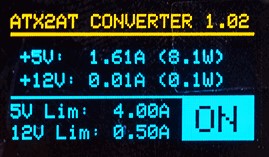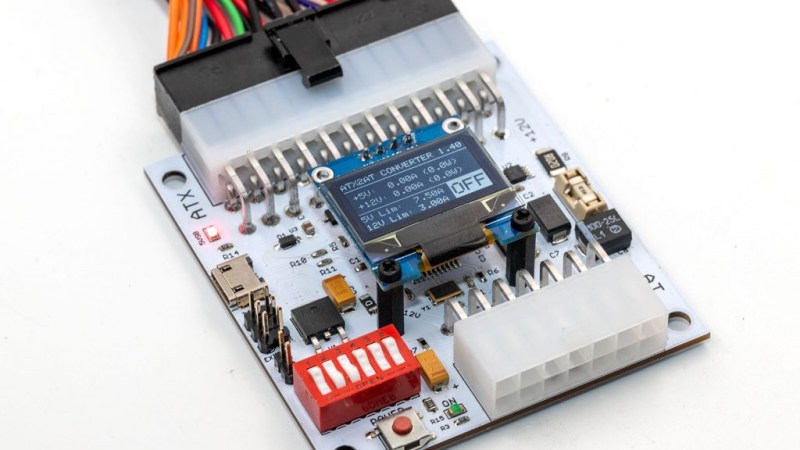It’s easy to take power supplies for granted in modern computing, but powering vintage hardware is not always so simple or worry-free. The power supplies for old electronics are themselves vintage, and the hardware being powered can be quite precious. A power problem can easily cause fried components and burned traces on a board. As [Doc TB] observes, by the time you hear crackling, it’s already far too late.
 To address this, [Doc TB] designed the ATX2AT Smart Converter as an open source project and recently decided to make it available through a Kickstarter campaign. ATX2AT is a way to safely and securely replace some vintage power supplies with a standard PC ATX power supply, and adds a large number of protection features such as current monitoring and programmable reaction time for overcurrent protection. All of this can help prevent a retrocomputer enthusiast’s precious vintage hardware from being damaged in the event of a problem. It’s not just for powering known-good hardware; it can be invaluable when testing or repairing hardware that might be in an unknown state.
To address this, [Doc TB] designed the ATX2AT Smart Converter as an open source project and recently decided to make it available through a Kickstarter campaign. ATX2AT is a way to safely and securely replace some vintage power supplies with a standard PC ATX power supply, and adds a large number of protection features such as current monitoring and programmable reaction time for overcurrent protection. All of this can help prevent a retrocomputer enthusiast’s precious vintage hardware from being damaged in the event of a problem. It’s not just for powering known-good hardware; it can be invaluable when testing or repairing hardware that might be in an unknown state.
When we first came across [Doc TB]’s ATX2AT project we recognized it as a well-made device to address a specific niche, and to do it well. Assessing risk takes into account not only the probability of a problem occurring, but also just how bad things would be if it did happen. If your old hardware is precious enough to warrant the extra protection, or you are into repairing or assessing old hardware, then an ATX2AT might be just what you need. You can see it in action in the video embedded below.















No UL testing, CE Mark, or FCC approval. Looks as safe as Chinesium, just with his words to back it up.
Except, you have the schematics and enough information to rate for yourself. Though third-party testing would be a nice stretch goal for the kickstarter.
Do you have any idea how much CE marking tests cost? If you knew you wouldn’t ask stupid questions.
About $30k, in my experience. And all you really get for that is a certificate saying you tested it against a standard. Was it the right standard? Was it the only standard? Did the standard cover every possible danger? Will they stand behind their testing if anything goes wrong? All answers are “no” in many cases.
Have submitted over 100 component power supply ‘families’ to various notified bodies, NRTLs, SCCs, etc. And have submitted over 20 power converters for use in medical equipment. The most recent power converter project was for a rack-mounted security server. The module bears an NRTL, an SCC, a NoM, a Bauart, and another EU lab Type test mark. I did the Type Tests, wrote the reports, and helped the auditor write the factory CIG report. Total cost was under $13k USD. But this does not include the recurring costs of license fees, audits, and popcorn and movies, etc during the life of the product.
The power converter’s end-use customer was a server box with certification for both EMC and safety that was done in less than three weeks, and most of their cost was sunk per their internal lab personnel (big company with big compliance lab). And their big time sink was the ECCN, HTS, and CCATS stuff. Their direct agency certification costs were less than $16k USD.
Caveat – the NRTLs and notified bodies do tend to punish the incompetent and ignorant with costs much greater than the above.
13k sounds right for a power supply. I think the 30k figure is for a product with non trivial rf. We had about the same experience with these types of products.
Are you certain whom is being ‘stupid’?
CE ‘marking’ costs almost nothing and means almost nothing. The CE mark only means that the vendor or manufacturer has supposedly written a declaration of conformity and is supposed to have compiled a technical construction file to document her stuff. The CE mark, for most stuff, does not require any third-party lab tests or construction evaluation. And enforcement within the EU is not consistent and is oft done by technically incompetent people.
If it is that easy to do, then there is absolutely reason not to at least try to do it then !
It’s a low voltage device without lithium batteries or other hazardous devices, UL testing not applicable.
Right, because most of the retro stuff you’re using with it has those…not.
IIRC pre 2000 ish, only things you saw with FCC numbers were modems, because they had to connect to fed regulated PSTN. The system integrator was supposed to handle the emissions etc for the whole caboodle. PSUs might have had UL testing but that was only on the 115/240V side.
Many expansion cards for PCs had FCC:ID numbers. Often it was the only way to track down manufacturers of parts in order to find drivers.
You must be the new intern! Welcome to hackaday! Diy pyrotechnics are over there, high voltage experiments in the next room, and didt i tell you already we are going to build a tig welder from used microwave transformers? Isnt that fun! ;)
B^)
Moose out front should have told ya.
So what about the anemic 5V line and yet overpowered (or rather excess current) 12V line of modern ATX power supplies?
And I suppose the missing -5V is also taken care of.
RTFA? Let me paste some of the relevent bits here so you dont stress yourself by clicking a link and looking at the big scary paragraphs
—
Integrated -5V Converter: the ATX2AT Smart Converter uses a 79M05 regulator to generate the missing -5V rail on modern ATX power supplies. It can be used with your nice AWE32 Upgrade Card or any other card that requires -5V.
—
—
+5V/+12V Programmable Over-Current Protection: Almost all pre-Socket 5 motherboard (from 8088 to early Pentium) drawn 90% of their power on +5V. But there is also some dramatic failures on the +12V rail, finding its way to the +5V and burning everything. The ATX2AT Smart Converter monitors the current drawn on both rail in real time. 8 different limits can be set with the dip switches. For example, 486 boards usually work fine with the default settings: 4.00A max for +5V and 500 mA (0.5A) for +12V. But you can also choose 1.50A/0.20A or up to 9A/5A.
—
“A fast acting transistor will blow itself up to protect the fuse.” – random .sig on usenet long time ago.
Not intending to sound like “you could’ve done it with a 555”
this could be of interest to some.
https://www.banggood.com/Geekcreit-XH-M229-Desktop-Computer-Chassis-Power-Supply-Module-ATX-Transfer-Board-Power-Output-Terminal-Module-p-1418198.html?cur_warehouse=USA
Like my previous comment above yours, fuses are okay for preventing fires, but too slow to protect the device.
Individual fuses might be more trouble than they are worth. If your device uses multiple rails, unexpected removal of one while the other rail(s) are active might cause a latch up. The only way to do this is to shut down the entire PSU, but that might already be too late as damages can be done in ns or us while shutdowns takes ms.
Thanks!
Cool. This is a good idea.